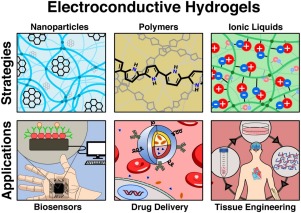Progress in Polymer Science ( IF 27.1 ) Pub Date : 2019-02-20 , DOI: 10.1016/j.progpolymsci.2019.02.007 Brian W Walker 1 , Roberto Portillo Lara 2, 3 , Emad Mogadam 4, 5 , Chu Hsiang Yu 2 , William Kimball 2 , Nasim Annabi 1, 6, 7

|
Electroconductive hydrogels (ECHs) are highly hydrated three-dimensional (3D) networks generated through the incorporation of conductive polymers, nanoparticles, and other conductive materials into polymeric hydrogels. ECHs combine several advantageous properties of inherently conductive materials with the highly tunable physical and biochemical properties of hydrogels. Recently, the development of biocompatible ECHs has been investigated for various biomedical applications, such as tissue engineering, drug delivery, biosensors, flexible electronics, and other implantable medical devices. Several methods for the synthesis of ECHs have been reported, which include the incorporation of electrically conductive materials such as gold and silver nanoparticles, graphene, and carbon nanotubes, as well as various conductive polymers (CPs), such as polyaniline, polypyrrole, and poly(3,4-ethylenedioxyythiophene) into hydrogel networks. These electroconductive composite hydrogels can be used as scaffolds with high swellability, tunable mechanical properties, and the capability to support cell growth both in vitro and in vivo. Furthermore, recent advancements in microfabrication techniques such as 3D bioprinting, micropatterning, and electrospinning have led to the development of ECHs with biomimetic microarchitectures that reproduce the characteristics of the native extracellular matrix (ECM). The combination of sophisticated synthesis chemistries and modern microfabrication techniques have led to engineer smart ECHs with advanced architectures, geometries, and functionalities that are being increasingly used in drug delivery systems, biosensors, tissue engineering, and soft electronics. In this review, we will summarize different strategies to synthesize conductive biomaterials. We will also discuss the advanced microfabrication techniques used to fabricate ECHs with complex 3D architectures, as well as various biomedical applications of microfabricated ECHs.
中文翻译:

用于生物医学应用的微细导电水凝胶的合理设计。
导电水凝胶(ECH)是高度水合的三维(3D)网络,是通过将导电聚合物,纳米颗粒和其他导电材料掺入聚合物水凝胶中而生成的。ECH将固有导电材料的多种优势与水凝胶的高度可调节的物理和生化特性相结合。近来,已经研究了生物相容性ECH的开发用于各种生物医学应用,例如组织工程,药物输送,生物传感器,柔性电子设备以及其他可植入医疗设备。已报道了几种合成ECH的方法,包括掺入导电材料,例如金和银纳米颗粒,石墨烯和碳纳米管,以及各种导电聚合物(CP),例如聚苯胺,聚吡咯和聚(3,4-乙撑二氧噻吩)进入水凝胶网络。这些导电复合水凝胶可用作具有高溶胀性,可调节的机械性能以及支持细胞生长的能力的支架体外和体内。此外,微细加工技术(例如3D生物打印,微图案和静电纺丝)的最新进展已导致具有仿生微体系结构的ECH的发展,这些仿生微体系结构再现了天然细胞外基质(ECM)的特征。先进的合成化学方法与现代微细加工技术的结合,使工程师能够设计出具有先进架构,几何形状和功能的智能ECH,这些ECH已越来越多地用于药物输送系统,生物传感器,组织工程和软电子产品中。在这篇综述中,我们将总结合成导电生物材料的不同策略。我们还将讨论用于制造具有复杂3D架构的ECH的先进微加工技术,以及微加工ECH的各种生物医学应用。



























 京公网安备 11010802027423号
京公网安备 11010802027423号